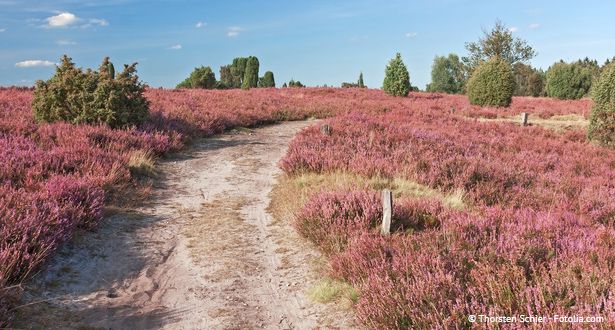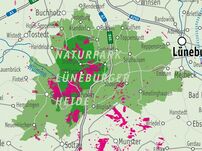Heathlands in the Nature Park
In addition to the connected heathlands in the Nature Reserve, there are a large number of other heathlands in Lüneburg Heath Nature Park that are worth exploring. On this page we would like to give you a quick summary and a closer look at a some of them.
You can also ask your local information centre for further tips and information about heathlands near you.
Heathlands in the Nature Conservation Area
The largest continuous heath areas in central Europe are located in the protected landscape area. This is where the best-known heathlands can be found. Here is a selection of particularly interesting areas:
On top of the Töps
About 2 km from the centre of Hanstedt is a heathland called "Auf dem Töps". It lies 109 m above sea level and has a wonderful view towards Hamburg. You will also find sheep pens and bee enclosures.
Osterheide
For some years now, the enjoyment of the heathland around Schneverdingen has been untroubled: the so-called "red areas", in which the British and Canadian military held training exercises for almost 50 years, have been returned to nature. In 1994, under the leadership of the Verein Naturschutzpark eV (VNP) and a British engineer unit, experts began extensive restoration and recultivation measures. In 1996 a new path and track network was completed. A mixture of wetlands, unimproved grassland, open sandy areas, and pockets of woodland make the once devastated area attractive again for locals and visitors. Osterheide is easy to reach by the road between Schneverdingen and Heber, where there are parking areas.
Steingrund
Steingrund is directly connected to Totengrund. It got its name because there are so many erratic boulders. The view across the heather and juniper is particularly impressive here.
Totengrund
Totengrund, a heathland valley between Wilsede, Sellhorn and Behringen, can be regarded as the seedbed of nature conservation in Germany. As early as 1906 this area was saved for nature conservation by Pastor Bode. This heathland is one of the most beautiful on Lüneburg Heath. You cannot go onto Totengrund itself. Footpaths lead along its upper edge and give a special view. You can get to Totengrund on foot or by bike, but also by horse carriage from Oberhaverbeck, Niederhaverbeck, Undeloh, Döhle, or Sudermühlen.
Wilseder Berg
Wilseder Berg is one of the most famous excursions on Lüneburg Heath. At the same time, at 169.2 m, it is the highest point on the Northwest German plain. Here, as in Totengrund, the history of nature conservation began in Lüneburg Heath. From Wilseder Berg you can look over wide heathlands. With clear visibility, you have views up to Lüneburg and Hamburg. Wilseder Berg can be reached on foot or by bike, but also by horse carriage from Oberhaverbeck, Niederhaverbeck, Undeloh, Döhle, or Sudermühlen.
Heathlands around Schneverdingen
In addition to the heathlands in the nature conservation area, there are further heathlands around Schneverdingen. In particular, we should mention Höpen:
Höpen
Höpen landscape protection area, on the edge of Schneverdingen, is home to some of the most beautiful and largest heathlands, which are accessible by cycle and hiking trails for recreation. From many parts of the Höpen hills you have distant views to Wilseder Berg. Around the edges you can find great food. Every year, on the last weekend in August, the Heather Queen is crowned at the open-air theatre. Just a few steps away you look down on the so-called "lower sheep pen", which has a flock of Schnucken (German grey heath) sheep at the beginning of April.
Heathlands around Handeloh
Around Handeloh it is worth mentioning Büsenbachtal.
Büsenbachtal
Büsenbachtal is another of our tips. It is north-east of Handeloh and is one of the most attractive nature and recreation areas in the northern area of the Nature Park. It covers about 50 hectares. It is characterized by gently rising valley sides with cultural-historical sandy heathland vegetation and scattered juniper stands. Büsenbachtal is crossed by the Büsenbach. The nutrient-poor flowing water is fed from a wetland spring. A special phenomenon here is a ponor (or swallow hole), where the watercourse seeps underground and reappears again later.


![[Translate to Englisch:] Siegel: Europäische Union – Europäischer Fond für regionale Entwicklung.](/fileadmin/_processed_/d/6/csm_europaeische-union-fond-regionale-entwicklung-logo_50eda43563.gif)
![[Translate to Englisch:] Logo Europa für Niedersachsen.](/fileadmin/_processed_/b/e/csm_europa-fuer-niedersachsen-logo_7b3947c73c.gif)
![[Translate to Englisch:] Logo Leader.](/fileadmin/_processed_/c/5/csm_leader-logo_c9a57e9ee0.gif)
![[Translate to Englisch:] Siegel: Europäische Union – Europäischer Landwirtschaftsfond für die Entwicklung des ländlichen Raums.](/fileadmin/_processed_/4/7/csm_europaeischer-landwirtschaftsfond-logo_ce24e54bf4.gif)
![[Translate to Englisch:] Logo touristischer Partner Lüneburger Heide.](/fileadmin/_processed_/4/3/csm_lueneburgerheide_positiv-mit-schatten_logo_00411b91a8.gif)